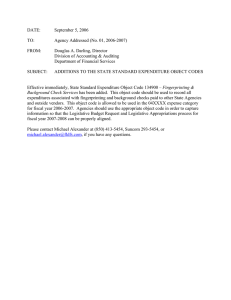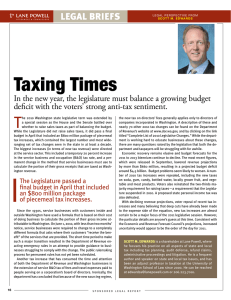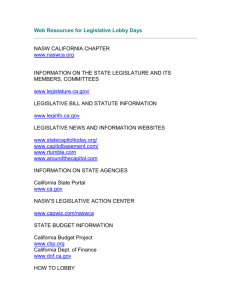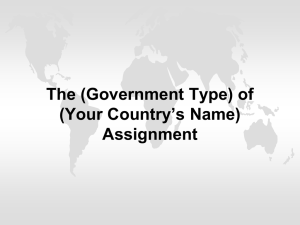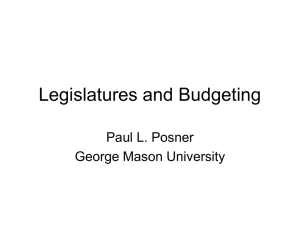Relationship between the Legislature and the Budget Office in the Budget Process
advertisement
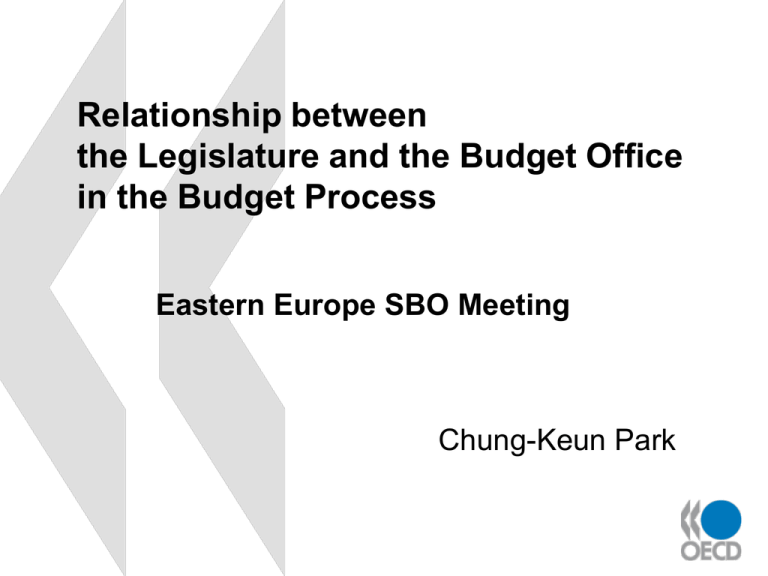
Relationship between the Legislature and the Budget Office in the Budget Process Eastern Europe SBO Meeting Chung-Keun Park 1. Background of this study Two key players in the budget process Increasing demand for active legislative involvement in the budget process OECD experts meeting in October, 2006 ; 9 countries with different power structure - Presidential : Mexico, U.S. Semi-Presidential : France, Korea Parliamentary : Italy, Japan, Netherlands, Sweden Westminster Parliamentary : U.K. 2 2. Factors affecting relationship between the Legislature and the Budget office Power structure - Presidential to Westminster Parliamentary Party system - Strong, cohesive two party system / weaker two party or multiple party system Structure of the legislature - Unicameral / bicameral Structure of the budget - Comprehensive / fragmentary 3 3. Recent trends Executive predominance in 20th century - Expansion of the government - Growth in technical complexity and bureaucracy - Rise of disciplined political party Recent resurgence of legislative role in budgeting - To improve deteriorating fiscal balance - Demand for transparency and accountability - Change from disciplined to fragmented party 4 4. Increasing legislative role, positive or negative for budgetary goals? Fiscal discipline - Feeble faith in their own institutional self restraint / greater fiscal responsibility Allocation - Narrow purpose for local constituency / broader national priorities Efficiency - Hamper administrative efficiency / provide sufficient flexibility Accountability 5 5. Interaction between the Legislature and the Budget Office in the Budget Process 6 (1) Budget preparation and submission Deadline for submission - On average, 3 months before new fiscal year begins Economic assumptions - MOF or shared responsibility of related ministries - Central Planning Bureau (Netherlands) • Legally independent body composed of 200 economists Medium-term budget frameworks - 75% of OECD countries prepare MTBFs (survey, 2003) - Not legal requirement in most countries, but significant in top-down budgeting - Coalition Agreement in the Netherlands 7 (2) Budget deliberation Legislative committees - Budget committee / Sectoral committees • Most countries have budget committee but the U.K. • Increase of entitlements for sectoral committees - Recent trend emphasizing balanced role of the two committees Legislative budget office - 3 out of 39 countries with more than 26 staffs (survey, 2003) - U.S. CBO (Congressional Budget Office) • Non partisan / 235 staffs with budgeting experiences • Providing legislative estimates and analysing proposal - Case of Korea, Italy and Sweden 8 (3) Budget approval Amendments - Presidential / Parliamentary Two-stage budget approval in Sweden - Spring Budget Bill; aggregate expenditure limit - Budget Bill; 27 sectoral ceilings and appropriations Earmarked provisions - Allocating resources for constituency / smoothing negotiation process in the legislature - Executive veto power; Line-Item Veto Act in the U.S 9 (4) Budget execution In-year report of budget execution to the legislature Appropriations accounts; simple·programmatic / complex·administrative Flexibility in execution process - Cancellation or postponement of appropriations is permitted under limited conditions • France (up to1.5%), U.S. (cancellation forbidden), Korea/Japan (supplementary budget) - End-year flexibility to avoid wasteful end-year surges Audit - From financial audit to performance audit 10 6. Budget reform Most reforms are initiated by the executive - They have more information and responsibility Legislative role in budget reform - Top-down budgeting in Sweden - The Budget Enforcement Act in the U.S. - Italy’s budget reform Requirements for successful budget reform - A common objective and co-operative attitude - Enacting the reform in a law as well as establishing it as a practice 11 7. Issues for discussion Tradeoff of more involvement of the legislature - Negative (Fiscal discipline, Efficiency) / Positive (Accountability) Issues to consider for strengthening budget process - Information sharing and collaboration of two bodies - Simplifying budget classification for transparency - Enhancing legislative capacity to analyze proposal - More utilization of performance information - Ensuring fiscal discipline in preparation for future fiscal risk (increasing entitlements, population ageing) 12
